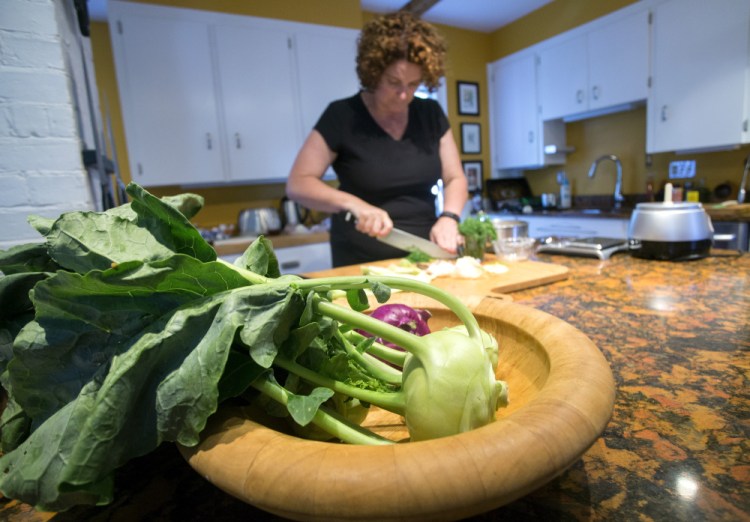I saw a kohlrabi bulb the size of a cantaloupe at the market last week. It brought back frightening memories of trying to force-feed my family all the kohlrabi included in my CSA share about 10 years ago – the farmer still had a lot to learn about crop diversity. The fear must have registered on my face as a fellow shopper wondered aloud how anyone could face using in its entirety a Brassica that big.
When I’m at the farmers market, I gravitate toward the extraordinary items. Bring on the ground cherries, shishito peppers, tatsoi and zucchini blossoms! That said, the three vegetables I still balk at bringing home are kohlrabi of any size, with or without its leaves; gnarly celery root; and huge, warty Hubbard squash.
But armed with a very sharp, 10-inch chef’s knife and a copy of Cara Mangini’s “The Vegetable Butcher,” I am determined to conquer my vegetable fears, starting with kohlrabi and moving onto the other two as the seasons progress. At the same time, I hope to pick up tips on how to select the best, waste as little as possible while prepping these thick-skinned vegetables, and serve them in dishes my family will eat happily.
Kohlrabi, in season for at least six months between late spring and early winter, shouldn’t be any scarier than its workaday cousins like broccoli, kale or Brussels sprouts in shredded raw slaws, steamed slices, roasted medleys and baked gratins, Mangini writes. I cross-checked the list of ingredients she pinpoints as good culinary kohlrabi companions with a similar one offered by Deborah Madison in “Vegetable Literacy.” Both agree that ingredients like chives, cumin, curry, dill, garlic, ginger, mustard and/or parsley suit kohlrabi dishes.
The huge kohlrabi I saw in the market was likely a Kossack, which are known for their girth and their ability to withstand long-term cold storage, thanks to an outer skin and a tough inner membrane. Both those layers need to be trimmed to reach the lightly colored, crisp flesh. To do that, Mangini instructs, take a thin slice off both the top and bottom of the bulb, rest it on the broadest cut end, and working from top to bottom, following the curve of the kohlrabi, slide the knife under the skin to remove it. From here you can slice, shred or dice the bulb according to your recipe’s instructions.
But Madison explains that it’s the young, small, tender kohlrabies (less than 4 ounces each) that you really want because they don’t need to be peeled at all.
Kohlrabies come in either white or purple and with leaves (which can be treated like any hearty green) or without. When choosing them, make sure they are firm to the touch, heavy for their size and have crisp, dark green leaves. That’s good advice for many a winter vegetable.
To store kohlrabi, Mangini advises separating the leaves from the bulbs as soon as you get home. Unwashed leaves will last in the refrigerator in an open plastic bag for four days while the bulbs can sit in the crisper drawer for as long as 10 days. Knowing that I can keep them around for that long before I need to use them up makes the prospect of doing so a little less scary.
ABOUT THE WRITER
CHRISTINE BURNS RUDALEVIGE is a food writer, a recipe developer and tester, and a cooking teacher in Brunswick. Contact her at: cburn1227@gmail.com.
Send questions/comments to the editors.




Comments are no longer available on this story